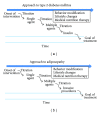Bariatric endocrinology: principles of medical practice
- PMID: 24899894
- PMCID: PMC4036612
- DOI: 10.1155/2014/917813
Bariatric endocrinology: principles of medical practice
Abstract
Obesity, is a chronic, biological, preventable, and treatable disease. The accumulation of fat mass causes physical changes (adiposity), metabolic and hormonal changes due to adipose tissue dysfunction (adiposopathy), and psychological changes. Bariatric endocrinology was conceived from the need to address the neuro-endocrinological derangements that are associated with adiposopathy, and from the need to broaden the scope of the management of its complications. In addition to the well-established metabolic complications of overweight and obesity, adiposopathy leads to hyperinsulinemia, hyperleptinemia, hypoadiponectinemia, dysregulation of gut peptides including GLP-1 and ghrelin, the development of an inflammatory milieu, and the strong risk of vascular disease. Therapy for adiposopathy hinges on effectively lowering the ratio of orexigenic to anorexigenic signals reaching the the hypothalamus and other relevant brain regions, favoring a lower caloric intake. Adiposopathy, overweight and obesity should be treated indefinitely with the specific aims to reduce fat mass for the adiposity complications, and to normalize adipose tissue function for the adiposopathic complications. This paper defines the principles of medical practice in bariatric endocrinology-the treatment of overweight and obesity as means to treat adiposopathy and its accompanying metabolic and hormonal derangements.
Figures
References
-
- Feneberg A, Malfertheiner P. Epidemic trends of obesity with impact on metabolism and digestive diseases. Digestive Diseases. 2012;30(2):143–147. - PubMed
-
- Clinical Guidelines on the Identification, Evaluation, and Treatment of Overweight and Obesity in Adults—The Evidence Report. National Institutes of Health. Obesity Research. 1998;6(2):51S–209S. - PubMed
-
- Clinical guidelines on the identification, evaluation, and treatment of overweight and obesity in adults: executive summary. Expert panel on the identification, evaluation, and treatment of overweight in adults. The American Journal of Clinical Nutrition. 1998;68:899–917. - PubMed
-
- Smith SR, Lovejoy JC, Greenway F, et al. Contributions of total body fat, abdominal subcutaneous adipose tissue compartments, and visceral adipose tissue to the metabolic complications of obesity. Metabolism: Clinical and Experimental. 2001;50(4):425–435. - PubMed
-
- NIH Health implications of obesity. National institutes of health consensus development conference statement. Annals of Internal Medicine. 1985;103:1073–1077. - PubMed
Publication types
LinkOut - more resources
Full Text Sources
Other Literature Sources



